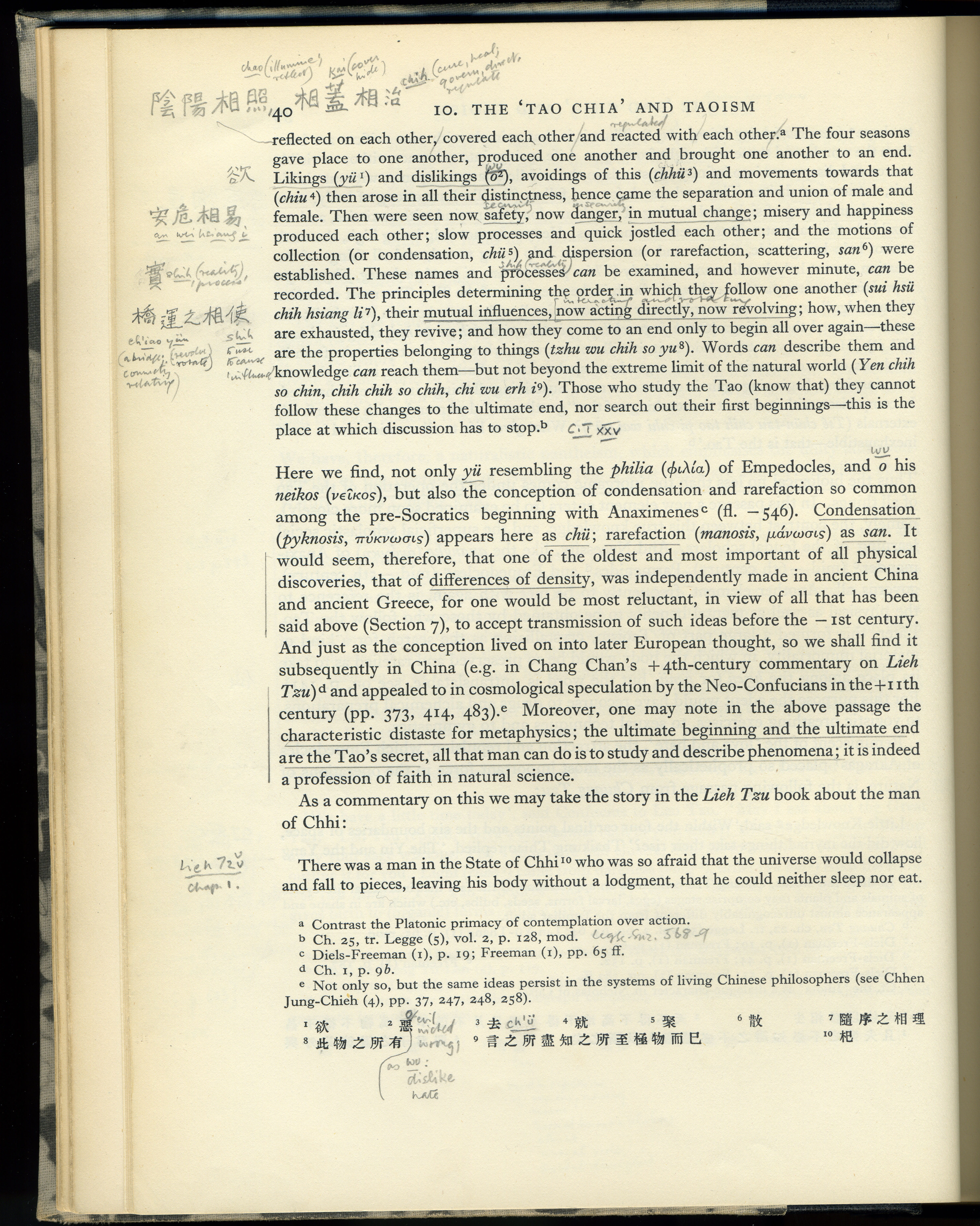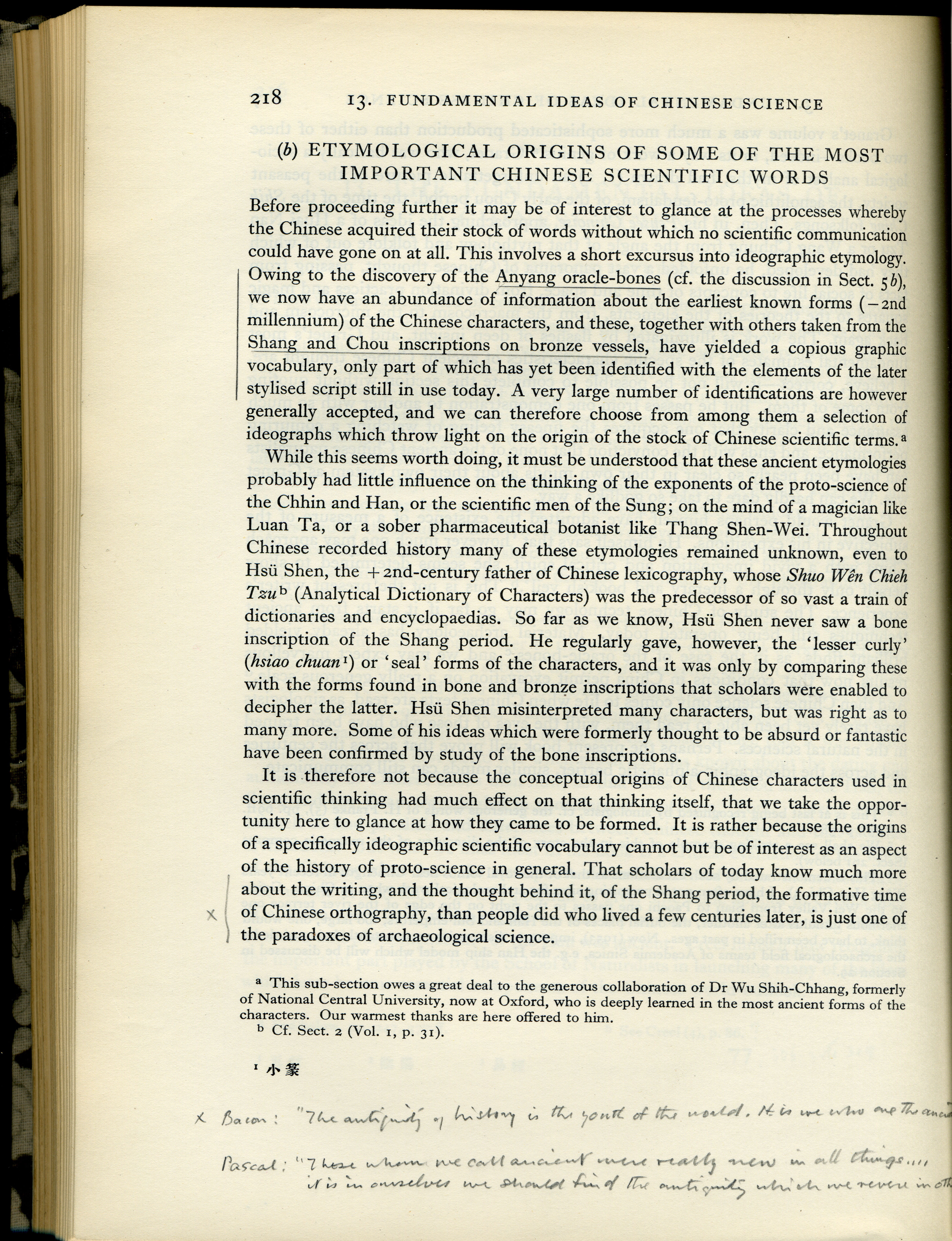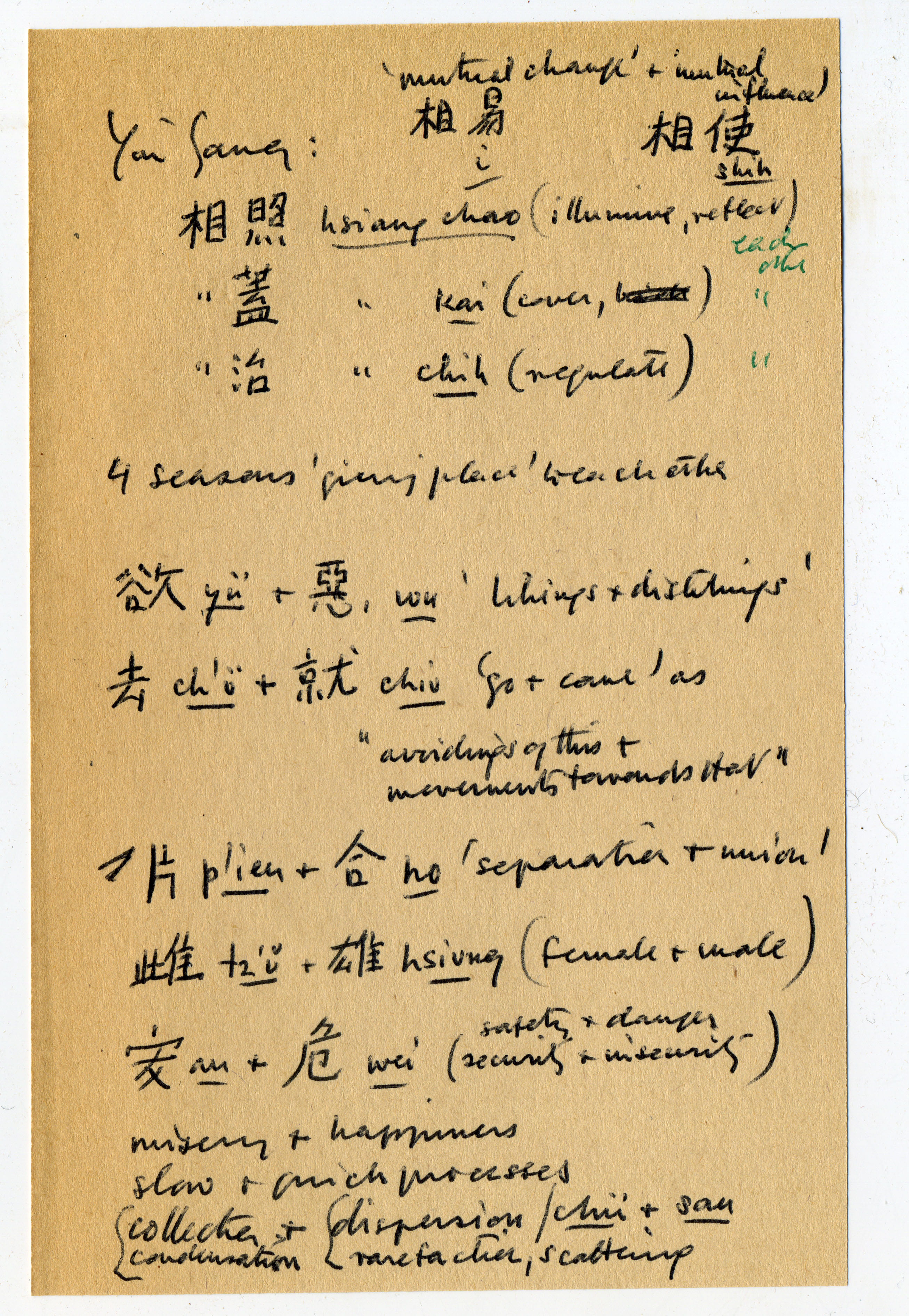By guest contributor Erin McGuirl
In studying annotations, we think of ourselves as entering into an otherwise impenetrable space: the mind of another reader. As I’ve looked closer and closer at Mai-mai Sze’s books and the marks she made in them, I’ve been especially curious about one thing. What motivated her to read so intensely? After all, she published only one work of scholarship in 1956 at the age of 47. After that she was neither writing nor teaching, but she was littering the margins of her books on eastern and western philosophy, religion, art, and history with notes in both English and Chinese. Why? As I’ve spent more time with both her as both reader and writer, I think I’m getting closer to an answer.
One of the books that Mai-mai read with the greatest care was Joseph Needham’s Science and Civilisation in China. Of the fifteen volumes she owned, the second on the history of scientific thought in China is by far the most carefully studied. In this book Needham comprehensively explores the relationship between Chinese philosophy and its role in shaping scientific thought and study in China. He boldly argued that Taoists, “whose speculations about, and insight into, Nature, fully equalled pre-Aristotelian Greek thought, and lie at the basis of all Chinese science.” ((1) For more on this argument, see Nathan Sivin’s fascinating study of the relationship between Taoists and science.) This controversial point was of great interest to Mai-mai, and guided her reading of every book in the series. While this entire volume is heavily annotated, her interests in Taosim in particular come to light through her extensive marginal notes in section 10, “The ‘Tao Chia’ and Taoism.”
Mai-mai’s interests in Taoist philosophy can be traced back to her translation of The Mustard Seed Garden Manual of Painting, which the Bollingen Foundation published in 1956 as a two-volume set with her only published piece of scholarship, The Tao of Painting: A Study of the Ritual Disposition of Chinese Painting. “The main intent of this inquiry,” as Mai-mai wrote in her introduction, “has been to seek a fresh approach to Chinese painting by exploring the main features of the tao or Chinese ‘way’ of painting and tracing and relating these aspects to the ideas a the source of Chinese life and thought.” (Volume 1, ix) The intention of volume two of The History of Science and Civilisation in China, published in the same year, was much the same, and I think that this that drove her to read the book with the remarkable intensity conveyed in her copious annotations.
Much like early modern readers like Gabriel Harvey or Adam Winthrop, Mai-mai read Needham alongside several other books, and cross-referenced these in her penciled notes. She occasionally references secondary sources, such as Percy J. Bruce’s study of the Neo-Confucianist Chu Hsi, but her most common references are to the philosophical texts that Needham used to support his arguments about the relationship between philosophy and science. Throughout the book, Mai-mai copied the original texts in Chinese into the margins, often with English translations by Arthur Waley others, contrasting Needham’s translations of Laozi, Zhuangzi, and other philosophers. Her copies of these texts – many published a decade or more after Science and Civilisation in China, suggesting that her interests in Needham’s work evolved over time – also contain references back to Needham.
Mai-mai’s interests in Taoism and her emphasis on the translation and interpretation of primary sources as a reader and annotator suggest two things. First, it establishes her as the Bollingen specialist on Chinese esotericism, alongside Cary F. Baynes, the translator of Richard Wilhelm’s German translations of the I Ching. As William McGuire makes clear in his memoir, Bollingen was as much a cohort of scholars and thinkers as it was a publishing enterprise. His memoir and correspondence with her (now part of his archive at the Library of Congress) show that her relationship with him and with some other Bollingen thinkers – particularly Maud Oakes and Natacha Rambova, both women artist-scholars without advanced academic training, like Mai-mai– continued almost to her death, long after the publication (and republication) of The Tao of Painting and the dissolution of the Bollingen Foundation by Paul Mellon in 1963. Although the specifics of her participation in and the overall cohesion of the group remain mysterious to me, her reading and her correspondence help to better situate Mai-mai within a very well defined group of writers and scholars with interests in esoteric humanism broadly conceived.
Second, Mai-mai’s annotations in English and Chinese show that language and translation were a lifelong obsession, continuing long after her only published translation of a Chinese text. Although she was born in China, she was raised primarily in England and America and spoke only rudimentary Chinese. Wellesley did not offer instruction in the Chinese while she attended the college in the late 1920s; she was entirely self-taught in classical form of the language. In The Tao of Painting, Mai-mai wrote much on the paleographical history and etymology of Chinese characters, expressing the relationships between the written language and the ways in which characters themselves help to illuminate certain philosophical concepts. While the book was positively reviewed in several publications, two critics – Nelson I. Wu and James F. Cahill – condemned the Tao of Painting, specifically because of errors in the translation and disagreements with her viewpoint in her study of the relationship between Chinese philosophy and painting. Cahill was particularly harsh, devoting three full pages to mistranslations and factual errors. These criticisms must have deeply wounded Mai-mai, a devoted reader of reviews. Considered alongside her annotations, which show the intensity and duration of her study of Chinese philosophy, language and translation, Nelson and Cahill’s criticisms may help to explain why the Tao of Painting was her first and last scholarly publication.
In the memoir of her child- and young adulthood, Echo of a Cry (1945), Mai-mai describes learning the French word deraciné: one who is uprooted from her native society. Throughout her life, Mai-mai struggled to bridge the gap between the disparate cultures she was raised in, without ever feeling that she was truly part of any one of them. This internal struggle took on an intense form and meaning in her reading and, at least up to 1956, her writing. Mai-mai’s reading was part of her search for identity in a world in which she felt she belonged to neither the culture of her birth in the east nor the society of her upbringing and adult life in the west. With Mai-mai Sze, reading, annotating, and translating was an intensely personal act that that helped her to situate herself in the world; it was a lifelong pursuit.
Erin Schreiner is the Special Collections Librarian at the New York Society Library. You can see Mai-mai Sze’s annotated books there at Readers Make Their Mark: Annotated Books (through to August 15, 2015).






June 15, 2015 at 2:29 pm
That’s a truly fascinating post. Marginalia reveal such richly human stories–when they’re studied this way!
June 16, 2015 at 11:55 am
Thanks so much, Tony! I overlooked her memoir for quite a while because the story ends when she’s about 21. Lucky for me, Cynthia Houng picked up on how interesting and unusual it is. Mai-mai explores some really mature and difficult questions in the book, even though she it wrote for children. Perhaps she wrote it as a way to explain herself to herself. I’m glad, though, that “Echo of a Cry” wasn’t enough. Beyond herself, there was a whole world to explore and understand, and did she get after it in her library!